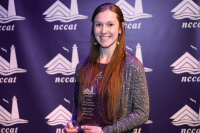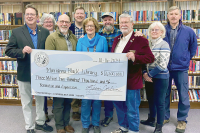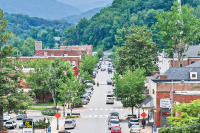South Main redesign could ‘raze’ the bar
South Main Street in Waynesville is headed for a major roadway redesign, one that could take out rows of long-time businesses to make way for more lanes, sidewalks, bike lanes and a median.
South Main Street — the two-lane thoroughfare that is the major artery between downtown and the new Super Wal-Mart — has long been in need of a makeover with an increasingly run-down appearance over the decades. Despite the close proximity of walkable neighborhoods, South Main lacks sidewalks in some sections. There is no curb: rather parking lots and the street form a continuous sea of asphalt. Despite the arrival of a Super Wal-Mart along the corridor, many lots and buildings remain vacant or perpetually for rent.
A road redesign has been high on the town’s list of project requests submitted to the N.C. Department of Transportation every year. The DOT has finally launched a feasibility study for the road, spurred by increased traffic brought on by the new Wal-Mart. The plan calls for keeping the road two lanes with intersection redesigns only, adding a single middle turn lane, or bumping up to four lanes with a raised median.
The Cadillac version of the redesign would claim a 120-foot wide swath of right-of-way: four lanes, a raised median, and bike lanes and sidewalks on both sides, along with curbs.
“If you did that, all these buildings would be gone,” said Waynesville Mayor Gavin Brown, standing on the side of South Main Street one day last week. “The necessity of having four lanes is in conflict with current uses.”
Brown doesn’t want to say good-bye to many of the long-time businesses that he grew up with, from a local Ace Hardware store to chili dogs at Jim’s Drive-In.
Related Items
“But in the long run, is it better for the community?” Brown asked, admitting that many of the businesses along the stretch have seen better days. “In 50 years from now, this entire corridor will be redeveloped.”
Brown envisions a new corridor that will have tree-lined sidewalks and rows of new businesses sporting aesthetic and pedestrian-friendly facades, as required by the town’s land-use plan.
“Its useful life for the most part has been expended,” Brown said of the current road design. “This is an opportunity for it to be a Phoenix.”
The widening could favor one side of the road or the other, claiming the majority of right of way from just one side of the road in an effort to preserve buildings on the other side, according to Eddie McFalls, a contracted road designer conducting the study for the DOT.
If town leaders, business owners and residents along the stretch don’t want to see large numbers of buildings taken out, a value call will come into play over which elements to cut, such as median or the sidewalks.
“Either it is going to be very wide or there will be trade-offs,” McFalls said.
Joel Setzer, the head of the DOT for the 10 western counties, said these are decisions that need to play out locally between town leaders and the community.
“We need a vision for the corridor,” Setzer said. Setzer said since South Main Street is mostly a local road and not integral to the state transportation network, the DOT is more likely to defer to local wishes.
“When you start looking at more of a local road, the designs and characteristics the local folks want weigh in even more,” Setzer said.
Residential section
The feasibility section is not only examining the commercial stretch of the road, but sections passing through residential neighborhoods as well. At one point, a DOT plan called for widening South Main Street through the South Main residential district known for its shady mature trees arching over the road, rock walls and affluent homes. Brown said the town would fight any plan that would ruin the character of the two-lane residential stretch.
“It is so comfortable to drive through the large, shady trees,” Brown said.
Setzer agrees.
“Based on the traffic counts, it doesn’t show we need to disturb that area,” Setzer said. “That was a big relief because no one really wanted to tackle that.”
It appears the DOT planners in Raleigh agree in principle.
“It would really change the character a lot to wipe out those trees,” said McFalls.
However, there is still the possibility of a middle lane being added at key side roads so people waiting to turn left into their neighborhood don’t back up traffic behind them, McFalls said. Brown agreed, partly.
“At the same time, I don’t want to create turn lanes for people who aren’t turning,” Brown said.









